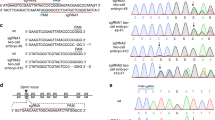Abstract
Two loci [l(7)5Rn and l(7)6Rn] defined by N-ethyl-N-nitrosourea (ENU)-induced, prenatally lethal mutations were mapped by means of trans complementation crosses to mice carrying lethal deletions of the albino (c) locus in Chromosome (Chr) 7. Both loci were found to map to the subregion of the Mod-2-sh-1 interval that contains the eed (embryonic ectoderm development) locus. eed has been defined by the inability of embryos homozygous for certain c deletions to develop beyond the early stages of gastrulation. Evidence for at least two loci necessary for normal prenatal development, rather than one locus, that map within the eed interval came from the observation that two prenatally lethal mutations, 3354SB [l(7)5Rn 3354SB] and 4234SB [l(7)6Rn 4234SB], could complement each other in trans, but could not each be complemented individually by c deletions known to include the eed locus. A somewhat leaky allele of l(7)5Rn [l(7)5Rn 1989SB] was also recovered, in which hemizygotes are often stillborn and homozygotes exhibit variable fitness and survival. The mapping of the loci defined by these mutations is likely to be useful for genetic, molecular, and phenotypic characterization of the eed region, and mutations at either locus (or both loci) may contribute to the eed phenotype.
Similar content being viewed by others
References
Brannan, C.I., Bedell, M.A., Resnick, J.L. Eppig, J.J., Handel, M.A., Williams, D.E., Lyman, S.D., Donovan, P.J., Jenkins, N.A., Copeland, N.G. (1992). Developmental abnormalities in Steel 17Hmice result from a splicing defect in the steel factor cytoplasmic tail. Genes Dev. 6, 1832–1842.
Davisson, M.T., Roderick, T.H., Doolittle, D.P. (1989). Recombination percentages and chromosomal assignments. In Genetic Variants and Strains of the Laboratory Mouse, 2nd ed. M.F. Lyon, A.G. Searle, eds. (Oxford: Oxford University Press), pp. 432–505.
Gluecksohn-Waelsch, S. (1979). Genetic control of morphogenetic and biochemical differentiation: lethal albino deletions in the mouse. Cell 16, 225–237.
Johnson, D.K., Hand, R.E., Jr., Rinchik, E.M. (1989). Molecular mapping within the mouse albino-deletion complex. Proc. Natl. Acad. Sci. USA 86, 8862–8866.
Klebig, M.L., Russell, L.B., Rinchik, E.M. (1992). Murine fumarylacetoacetate hydrolase (Fah) gene is disrupted by a neonatally lethal albino deletion that defines the hepatocyte-specific developmental regulation 1 (hsdr-1) locus. Proc. Natl. Acad. Sci. USA 89, 1363–1367.
Niswander, L., Yee, D., Rinchik, E.M., Russell, L.B., Magnuson, T. (1988). The albino-deletion complex and early postimplantation survival in the mouse. Development 102, 45–53.
Niswander, L., Yee, D., Rinchik, E.M., Russell, L.B., Magnuson, T. (1989). The albino-deletion complex in the mouse defines genes necessary for development of embryonic and extraembryonic ectoderm. Development 105, 175–182.
Peters, J., Jones, J., Ball, S.T., Clegg, J.B. (1990). Analysis of electrophoretically detected mutations induced in mouse germ cells by ethylnitrosourea. In Banbury Report 34 (Cold Spring Harbor, N.Y.: Cold Spring Harbor Laboratory Press), pp. 247–257.
Popp, R.A., Bailiff, E.G., Skow, L.C., Johnson, F.M., Lewis, S.E. (1983). Analysis of a mouse α-globin gene mutation induced by ethylnitrosourea. Genetics 105, 157–167.
Rinchik, E.M., Carpenter, D.A., Selby, P.B. (1990). A strategy for fine-structure functional analysis of a 6- to 11-cM region of mouse chromosome 7 by high-efficiency mutagenesis. Proc. Natl. Acad. Sci. USA 87, 896–900.
Rinchik, E.M., Magnuson, T., Holdener-Kenny, B., Kelsey, G., Bianchi, A., Conti, C.J., Chartier, F., Brown, K.A., Brown, S.D.M., Peters, J. (1992). Mouse Chromosome 7. Mammalian Genome 3(Suppl): S104-S120.
Ruppert, S., Kelsey, G., Schedl, A., Schmid, E., Thies, E., Schutz, G. (1992). Deficiency of an enzyme of tyrosine metabolism underlies altered gene expression in newborn liver of lethal albino mice. Genes Dev. 6, 1430–1443.
Russell, L.B., Rinchik, E.M. (1987). Genetic and molecular characterization of genomic regions surrounding specific loci of the mouse. In Banbury Report 28 (Cold Spring Harbor, N.Y.: Cold Spring Harbor Laboratory Press), pp. 109–121.
Russell, L.B., Montgomery, C.S., Raymer, G.D. (1982). Analysis of the albino-locus region of the mouse. IV. Characterization of 34 deficiencies. Genetics 100, 427–453.
Russell, L.B., Russell, W.L., Rinchik, E.M., Hunsicker, P.R. (1990). Factors affecting the nature of induced mutations. In Banbury Report 34 (Cold Spring Harbor, N.Y.: Cold Spring Harbor Laboratory Press), pp. 271–285.
Sharan, S.K., Holdener-Kenny, B., Ruppert, S., Schedl, A., Kelsey, G., Rinchik, E.M., Magnuson, T. (1991). The albinodeletion complex of the mouse: molecular mapping of deletion breakpoints that define regions necessary for development of the embryonic and extraembryonic ectoderm. Genetics 129, 825–832.
Sharan, S.K., Holdener-Kenny, B., Threadgill, D.W., Magnuson, T. (1992). Genomic mapping within the albino-deletion complex using early postimplantation mouse embryos. Mammalian Genome 3, 79–83.
Zdarsky, E., Favor, J., Jackson, I.J. (1990). The molecular basis of brown, an old mouse mutation, and of an induced revertant to wild type. Genetics 126, 443–449.
Author information
Authors and Affiliations
Rights and permissions
About this article
Cite this article
Rinchik, E.M., Carpenter, D.A. N-Ethyl-N-nitrosourea-induced prenatally lethal mutations define at least two complementation groups within the embryonic ectoderm development (eed) locus in mouse Chromosome 7. Mammalian Genome 4, 349–353 (1993). https://doi.org/10.1007/BF00360583
Received:
Accepted:
Issue Date:
DOI: https://doi.org/10.1007/BF00360583




